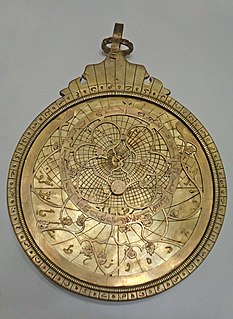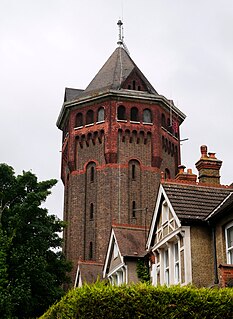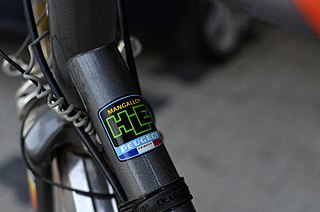Related Research Articles

An alloy is a mixture of chemical elements of which at least one is a metal. Unlike chemical compounds with metallic bases, an alloy will retain all the properties of a metal in the resulting material, such as electrical conductivity, ductility, opacity, and luster, but may have properties that differ from those of the pure metals, such as increased strength or hardness. In some cases, an alloy may reduce the overall cost of the material while preserving important properties. In other cases, the mixture imparts synergistic properties to the constituent metal elements such as corrosion resistance or mechanical strength.

Brass is an alloy of copper and zinc, in proportions which can be varied to achieve varying mechanical, electrical, and chemical properties. It is a substitutional alloy: atoms of the two constituents may replace each other within the same crystal structure.

Bronze is an alloy consisting primarily of copper, commonly with about 12–12.5% tin and often with the addition of other metals and sometimes non-metals, such as phosphorus, or metalloids such as arsenic, or silicon. These additions produce a range of alloys that may be harder than copper alone, or have other useful properties, such as strength, ductility, or machinability.

Metallurgy is a domain of materials science and engineering that studies the physical and chemical behavior of metallic elements, their inter-metallic compounds, and their mixtures, which are known as alloys. Metallurgy encompasses both the science and the technology of metals; that is, the way in which science is applied to the production of metals, and the engineering of metal components used in products for both consumers and manufacturers. Metallurgy is distinct from the craft of metalworking. Metalworking relies on metallurgy in a similar manner to how medicine relies on medical science for technical advancement. A specialist practitioner of metallurgy is known as a metallurgist.

Sir Henry Bessemer was an English inventor, whose steel-making process would become the most important technique for making steel in the nineteenth century for almost one hundred years from 1856 to 1950. He also played a significant role in establishing the town of Sheffield—nicknamed ‘Steel City’—as a major industrial centre.

Cast iron is a group of iron–carbon alloys with a carbon content more than 2%. Its usefulness derives from its relatively low melting temperature. The alloy constituents affect its color when fractured: white cast iron has carbide impurities which allow cracks to pass straight through, grey cast iron has graphite flakes which deflect a passing crack and initiate countless new cracks as the material breaks, and ductile cast iron has spherical graphite "nodules" which stop the crack from further progressing.
Peter William Barlow was an English civil engineer, particularly associated with railways, bridges, the design of tunnels and the development of tunnelling techniques. In 1864 he patented a design for a cylindrical tunnelling shield, and obtained a provisional patent in 1868 for an improved design.

Charlton is an area of southeast London, England, within the Royal Borough of Greenwich. It is east of Greenwich and west of Woolwich. It is 7.2 miles (11.6 km) east-southeast of Charing Cross. 'Charlton next Woolwich' was an ancient parish in the county of Kent, which became part of the metropolitan area of London in 1855. It is home to Charlton Athletic and to Charlton House.

Shooter's Hill is a district in South East London within the Royal Borough of Greenwich. It borders the London Borough of Bexley. It lies north of Eltham and south of Woolwich. With a height of 132 metres (433 ft), it is the highest point in the Borough of Greenwich and one of the highest points in Greater London. Shooter's Hill also gives its name to the A road which passes through east to west and is part of the A207 road, the A2 road, and also Watling Street.
Manganese Bronze Holdings plc (MBH) was the holding company of LTI Limited. The firm's sole business in its final years as a company was London black taxicab manufacturing through the LTI subsidiary.

Alexander Lyman Holley was an American mechanical engineer, inventor, and founding member of the American Society of Mechanical Engineers (ASME). He was considered the foremost steel and plant engineer and designer of his time, especially in regard to applying research to modern steel manufacturing processes.

Sir Robert Abbott Hadfield, 1st Baronet FRS was an English metallurgist, noted for his 1882 discovery of manganese steel, one of the first steel alloys. He also invented silicon steel, initially for mechanical properties which have made the alloy a material of choice for springs and some fine blades, though it has also become important in electrical applications for its magnetic behaviour.

John Penn (1805–1878) was an English marine engineer whose firm was pre-eminent in the middle of the 19th century due to his innovations in engine and propeller systems, which led his firm to be the major supplier to the Royal Navy as it made the transition from sail to steam power. He was also president of the Institution of Mechanical Engineers on two occasions.

Mangalloy, also called manganese steel or Hadfield steel, is an alloy steel containing an average of around 13% manganese. Mangalloy is known for its high impact strength and resistance to abrasion once in its work-hardened state.
Bal Raj Nijhawan, was an Indian metallurgist, author and the first Director of Indian origin of the National Metallurgical Laboratory, Council of Scientific and Industrial Research (CSIR). He was a recipient of Shanti Swarup Bhatnagar Prize, the highest Indian science award, which he received in 1964 in the Engineering sciences category. The Government of India honoured him in 1958, with the award of Padma Shri, the fourth highest Indian civilian award for his services to the nation.
Richard William Bailey FRS was a British mechanical engineer and research engineer.

Sir Ernest William Moir was a British civil engineer and the first Moir baronet. He is credited with inventing the first medical airlock while working on the Hudson River Tunnel in New York in 1889.
J. Stone & Co was a British marine and railway engineering company based in Deptford in south east London, particularly noted for the manufacture of nails and rivets, Stone-Lloyd watertight ships' doors, brass ships' propellers, iron manhole covers, pumps, and railway carriage electric lighting and air conditioning systems. Stone Foundries and Stone Fasteners continue to operate in Charlton.

Marvin J. Udy was an American scientist, inventor, chemical engineer, metallurgist, and entrepreneur who is best known for his development of the Udylite process for cadmium plating as well as processes to refine chromium, nickel, cobalt and bismuth.
References
- 1 2 3 4 Obituary: Perceval Moses Parsons, Iron and Steel Institute, 1892. Reproduced in Grace's Guide to British Industrial History: Perceval Moses Parsons. Accessed: 6 November 2019.
- 1 2 3 4 5 6 7 Obituary: Perceval Moses Parsons, Institution of Civil Engineers, 1893. Reproduced in Grace's Guide to British Industrial History: Perceval Moses Parsons. Accessed: 6 November 2019.
- ↑ LeClair, Daniel R. (2019). The British Military Revolution of the 19th Century: "The Great Gun Question" and the Modernization of Ordnance and Administration. McFarland. p. 166. ISBN 9781476674995.
- ↑ Seaton, Albert E (2013). The Screw Propeller. BoD. p. 196. ISBN 9783954272730.
- ↑ "P. M. Parsons". Grace's Guide to British Industrial History. Retrieved 6 November 2019.
- 1 2 "Percival Moses Parsons – with a foundry in Banning Street". Greenwich Peninsula History. Retrieved 6 November 2019.
- ↑ "Perceval Moses Parsons". Find a Grave. Retrieved 6 November 2019.
- ↑ "Anne Jane Rexford Parsons". Find A Grave. Retrieved 24 January 2020.